This post may contain affiliate links.
So, how much does it cost to travel in an RV? It’s been a year since our last financial snapshot and so here’s an update on our RV lifestyle and travel expenses. It was quite an eye-opener. With the numbers coming in around 50% higher than the year before. In this infographic, we share the reasons, along with our total miles traveled, nights stayed in various locations. Also, what we spent on campgrounds, fuel, repairs, insurance, and other non-RV-related travel.
2023 Update: We also have TONS of more information about how much it costs to travel in an RV. Here is a quick list of a few other blog posts on our website on this topic:
- RV camping costs after six years of full time
- The real cost of RV ownership after six years of full-time RVing
- Cost of RV travel, comparing full-time vs part-time
Watch the video recap here – against a full moon in Sedona, AZ. And/or scroll down to keep reading.
Of course the important thing to note here is the costs related to a life of RVing and travel can widely from year to year and from person to person. There are many variables in how much it costs to travel in an RV. Variables can depend on your type and age of RV. How do you travel? The pace at which you travel, your standard of living, fuel prices and so much more. It all plays a big part. So please keep that in mind.
Also note: We have NOT included our RV monthly payment, grocery/eating out and entertainment expenses in this post. These are all totally variable depending on your own personal preferences and budget. But we hope you find the data we’ve shared in this infographic interesting and useful as a guide. We’ve included some additional commentary, observations and explanations below the image.
If want the full picture of how much it costs to travel in an RV, check out our more comprehensive blog posts mentioned above in the 2023 update.
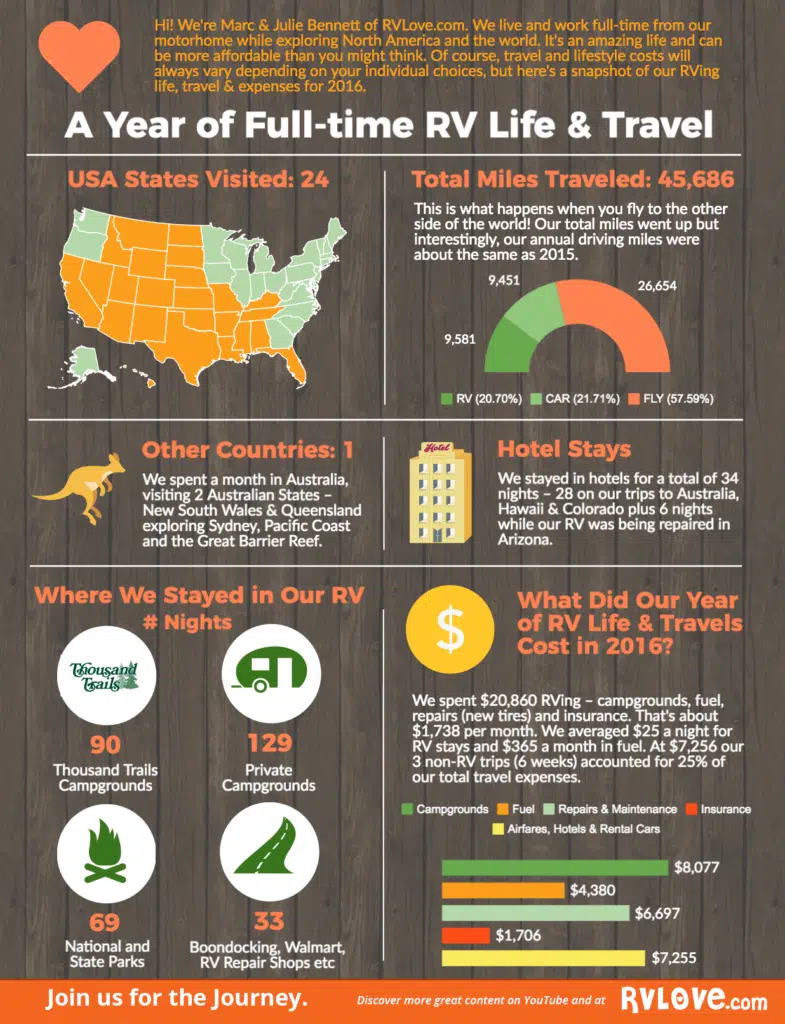
Go Big Or Go Home...Better Yet, Do Both!
We went REALLY BIG in 2016, spending about double on our travels compared to 2015. But boy, did we have an AWESOME time. And yes, we did go home. Both to Colorado and Australia.
We spent about $28K for the two of us (compared to $14K in 2015). This is including our trips to Australia, Colorado and Hawaii (5 weeks all up). However, once we exclude the 2 off-shore trips, that brings our RV travel expenses down to about $20K. Of course, had we spent those 5 weeks in mainland USA instead of Hawaii or Australia, our expenses would have probably been more like $21K (instead of $20K). So let’s call it about a 50% increase. This is a more accurate comparison if you only want to consider RV travel related expenses.
There are good reasons for the higher costs, which we’ll cover as we continue.
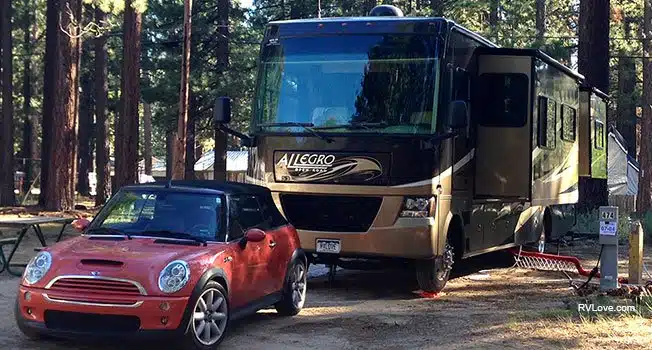
Campground Expense Cost of Traveling in an RV
When it comes to the question of how much does it cost to travel in an RV, one of the biggest pieces are your campground expenses. Our campground expenses were substantially higher – almost 50% higher in 2016 costing $8,077 vs $5,645. But this didn’t come as a surprise either.
We knew when we were planning our 2016 travel itinerary that we would be spending a lot of time in the middle of the country, where our camping membership through Thousand Trails (TT) doesn’t have much of a presence (or any).
2022 Update: Thousand Trails added a new campground in Colorado. You can read our review of Blue Mesa Recreational Ranch here.
As many of you know, we try to spend as much time as possible in Thousand Trails parks because it saves us SO much money. It is especially valuable as full-timers. But in 2016 we spent a mere 90 nights in TT campgrounds. That is less than half the time we spent in 2015 (189 nights). And that came at a price of course, being an additional $2,432 (which averages out at about $25 a night.)
2023 Update: We have now spent well over 900 nights in Thousand Trails. And our average costs have come down even more. Read all about it in this blog post: Is Thousand Trails Worth it? Our Comprehensive Review.
We spent a similar number of days in private and membership campgrounds outside of TT. And about twice as many in State and National Parks, which was fantastic!
We also did more boondocking and dry camping in 2016 than we did in 2015. Now that we have so much more experience, we feel much more comfortable doing this now. So 33 nights up from 20. This included overnighters at Walmart and rest stops. And a longer stay at the Albuquerque Balloon Fiesta. Plus a few nights dry camping at an RV service center waiting to get repairs done!
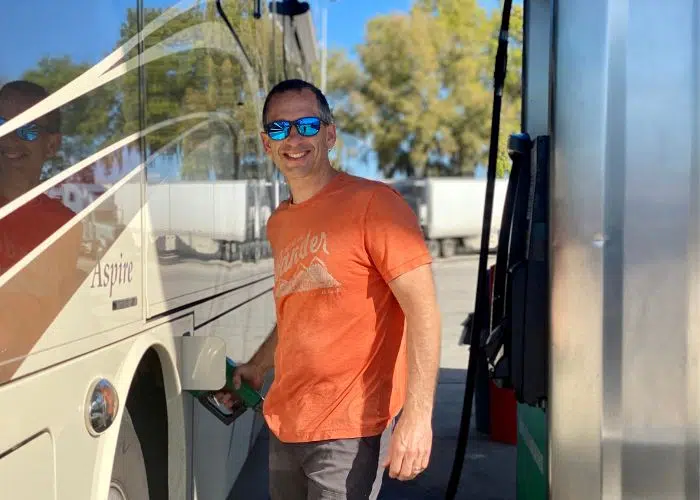
Fuel Expense Costs to Travel in an RV
Of course, flying some 26,000+ miles skewed our overall total. But interestingly, our driving miles were very similar to the previous year.
In 2016, we traveled to 24 USA states instead of 33. Yet we drove 9,581 miles in the RV. That’s an extra 1,173 miles than 2015 when were on the east coast where states are smaller and closer together. In 2016, we drove through more of the bigger states in the west. States like Montana and all the way up to North Dakota. North Dakota is the lone state often missing from the state sticker maps of so many RVers. But not missing on ours now….haha. And of course, there were many miles to drive across Kansas and Texas. Oh Texas, you are SO big
We drove 9,451 miles by car. Which includes miles in the MINI as well as rental cars in Australia and Hawaii. We felt it was fair to include those. Because if we hadn’t been there, we would have been driving somewhere else back in the USA. But overall, our regular vehicle miles were lower than the previous year. Our average miles came in at just under 800 miles a month, compared to 950.
If you combine our RV and car driving miles, that comes to just under 20K. And we drove 24 states in the USA (almost half the country) plus 2 (big) states in Australia.
Now just think about that for a minute. The average American drives around 13,476 miles per year, according to the U.S. Department of Transportation Federal Highway Administration (FHWA). And most households probably have 2 vehicles which would easily take that total number to over 25,000 miles. Most of these miles are done commuting to and from work. Not traveling and exploring. Hmmmmm.
Fuel Costs
Not surprisingly, because we drove around the same miles as last year and fuel prices have been reasonably stable, our fuel expenses came within $100 of the year before. The total came in at $4,380.
2023 Update: We also have comprehensive Fuel costs for RVing after six years of full-time RVing post.
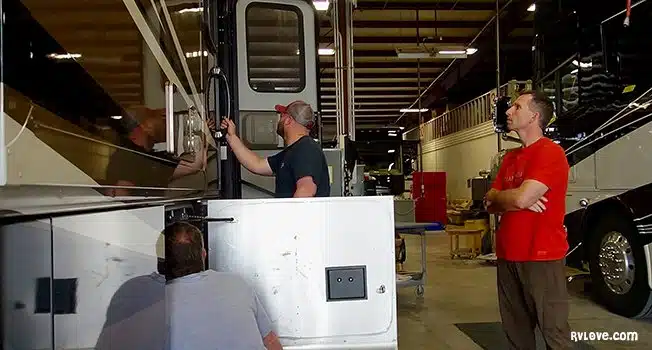
Repairs and Maintenance
When asking how much does it cost to travel in an RV, one of the biggest unknowns is the cost of RV maintenance and repairs.
Our wallets took a much bigger hit in 2016. But it wasn’t entirely surprising. We were planning on replacing our RV tires in 2016 as our coach is a 2012 model (2011 chassis). Therefore the tires are over 5 years old. Also, our RV is no longer under a factory warranty. And of course, the older your RV gets, the more you’re going to need to expect to spend on repairs and maintenance.
All up, our Repair and Maintenance costs were more than 3X the year before at $6,697. And it would have been even higher if it wasn’t for our extended service contract). Over half of our overall repairs and maintenance expense were spent on putting 6 new tires on the RV. Also, we replaced 2 tires on the MINI ($3,456), which we classify as maintenance rather than repairs. We also upgraded our RV suspension with Sumo Springs, which made a huge improvement to the drive and handling of our gas coach. That was another $1,450 but was entirely optional.
In May 2016, we took a trip to Tiffin, our coach manufacturer, and had a great experience there. We spent under $500 and had a ton of work done for that. Repairs and even some body/paint work. You can read more about that here.
Other repairs and maintenance are detailed in this 2-part blog post/video, which cover the 3 breakdowns we had in November! See Part 1 here and see Part 2 here.
What far more detailed information on how much it costs to travel in an RV?
We also have TONS of more information about how much it costs to travel in an RV. Here is a quick list of a few other blog posts we think you should definitely check out.
- RV camping costs after six years of full time
- The real cost of RV ownership after six years of full-time RVing
- Cost of RV travel, comparing full-time vs part-time
Insurance
As per usual, our insurance premium renewal arrived and was higher than the year before – by a few hundred dollars! I called our insurer and they offered to run our credit score. Lo and behold, this resulted in a premium reduction. It definitely pays to make a call. Our insurance costs actually went down to just over $1700 for our combined RV and MINI policy. Our previous year’s policy was $2,100.

Other Travels
All up, we actually spent 67 nights outside of our RV (just over 2 months). Which is why this post and Infographic is not just about our RV life. It is about our RV Life and Travels. Our plan is to keep on expanding our travels internationally, while maintaining our RV in the USA as our home base.
Accommodations include a combination of very nice hotels (Australia, Hawaii and Colorado). Plus freebie stays with family and friends (in Australia). We included the cost of our non-RV travels under Airfares, Hotel Stays & Rental Cars at the very bottom right of the Infographic.
These came to a total of $7,255. This may sound like a lot. But remember that’s for 6 weeks for 2 people and includes a long haul international flight, plus 2 others domestic ones. Our stays with family and friends were free and our trips to Hawaii and Colorado were heavily subsidized by using frequent flier miles/points. So, these travel expenses were actually very reasonable for what we got. We stayed in really nice places and we have a high value on cool cars. Our Mustang rental car to drive all around Maui in December was 100% paid for by points we earned from our credit cards.

Summary
Typically, we like to keep on top of our expenses on a monthly basis. But 2016 was such a hectic year of life, work and travel that we fell off the wagon with that routine. So it ended up being a huge job to go back and compile the data, over the past few weeks for this blog post.
Overall, even WE were surprised at how much more we spent on travel in 2016 compared to the year before. But we remind ourselves that it’s still not unreasonable for such a huge amount of travel and amazing experiences. The amount we spent was within our means. Travel is high value for us and this expenditure is still comparable to a “normal life” with a mortgage, 2 cars and the associated expenses.
We also hadn’t been back to Australia to visit family for over 3 years. So that trip was overdue and we scored bargain flights that we simply couldn’t say no to. Now that we’ve covered all of the lower 48 USA states plus Hawaii, we’ll be slowing down our pace in 2017 and the years ahead.
When you’re in your first few years on the road as an RVer, there’s just something about wanting to hit every state you can. This is especially true when you have one of those darned state sticker maps on the side of your RV! We continue to love this lifestyle and it’s exciting to think we’ve covered every state now, except for Alaska – all while working full-time. We plan to explore the last frontier in 2018.
What far more information on how much it costs to travel in an RV?
We also have TONS of more information about how much it costs to travel in an RV. Here is a quick list of a few other blog posts we think you should definitely check out.
- RV camping costs after six years of full time
- The real cost of RV ownership after six years of full-time RVing
- Cost of RV travel, comparing full-time vs part-time
Sign up for our email newsletter with the latest RV park reviews, news and updates.
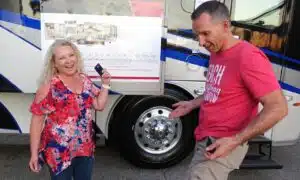
Values Of RVs. What’s My RV Worth?
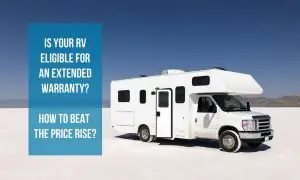
When to Buy an RV Warranty For Best Value
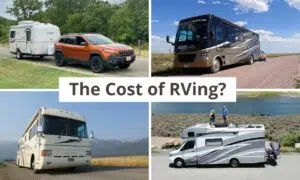
Cost of RVing – Full Time vs Part Time?
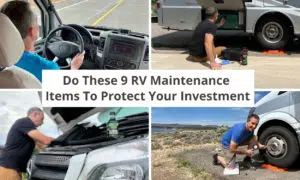
9 RV Maintenance Items To Protect Your Investment
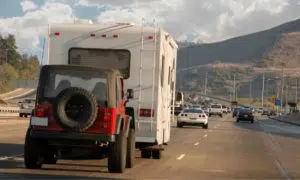
The State of RV Repairs: Problems, Solutions and On-Demand RV Techs
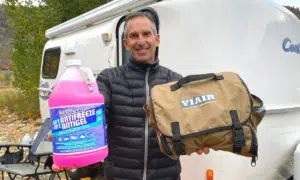
How To Winterize An RV: What You Need
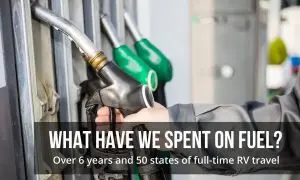
Fuel Costs Over 6 Years of Full Time RV Life
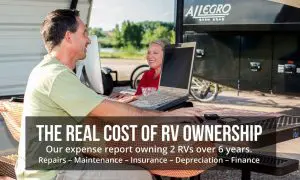
The Real Cost of RV Ownership. Here’s What We Spent.
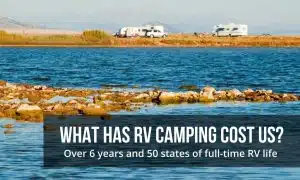
RV Camping Costs over 6 years of Full-Time RVing
GOT COMMENTS OR QUESTIONS?
We would love to hear from you. Drop us a note in the comments section below.

26 thoughts on “How Much Does It Cost To Travel In An RV?”
I have reviewed the videos and the charts, but I am not sure why you would spend so many nights outside of the TT program. Do you not have the Trails Collection as well?
Also, when you store your unit at a TT site, do you know what the average costs are?
Hi John, we love our TT membership and how much it saves us, and if our #1 goal was saving money and cheap camping, we WOULD spend more time in the TT system. In fact we know many who stay in TT 300 or more nights a year. But for us, it subsidizes the rest of our RV travels, as TT campgrounds – and Trails Collection which we also have – are not always in the geographical areas we choose to travel to. Storage varies from location to location, but we have paid around $3-5 a night for storage. Hope that helps!
WHY DID YOU SWITCH TO A 1999 RV? TT WON’T TAKE OLDER RV’S WILL THEY?
HI Hazel you will find a ton of info – article and videos – about our decision here:
https://rvlove.com/2018/07/23/first-rv-tour-introducing-our-new-to-us-motorhome-cc
https://rvlove.com/2018/09/09/qa-video-why-did-we-buy-an-older-rv-many-more-questions-answered/
Buying an older RV certainly isn’t for everyone, but it turned out to be the right decision for us. There is no age limit to RVs within the Thousand Trails camping network. Some Encore RV Parks DO have an age limit, as do some other RV parks, but generally speaking, we have found the “10 year age rule” to have little impact on us, even with our 20yo coach.
I live in New Jersey and plan to become a full-time traveler by the end of the summer will be down sizing selling my home and I’m very excited and scared to I will check out your class to see if we can begin to learn a few things we obviously need to
Good for you! Excited and scared is very normal! Yes our book “Living the RV Life – Your Ultimate Guide to Life on the Road” will give you the fastest head start and then when you are ready to take a deeper dive before you start RV shopping, our courses will help you even more. And yes there is a LOT to learn. Good luck! Hope you find our content helpful.
thank you for your blogs. We are learning a lot as my husband and I are in the process of selling our home and purchasing a Class A. You mentioned your school in Las Vegas. What school is this as we live in Las Vegas and would love to learn more about Rving.
thank you for your blogs. We are learning a lot as my husband and I are in the process of selling our home and purchasing a Class A. You mentioned your school in Las Vegas. What school is this as we live in Las Vegas and would love to learn more about Rving.
Hi Dale, Congratulations on your decision to sell your home and join us out on the road! We created an online school ‘RV Success School’ with online courses to help people learn, understand and navigate their way through the path to selling their home, buying an RV and hitting the road – basically it covers everything you are going through right now – and a whole lot more you likely haven’t thought about. Everything from Choosing the Right RV for You to downsizing, preparing, the emotional transition, travel and route planning, safety and so much more. You can learn more here http://www.rvsuccessschool.com – and know that our courses come with a 100% money back guarantee. You might appreciate what others have to say about their experience doing the courses and going through the workbooks and resources as well. It will guide and support you along the journey, AND save you a ton of time and money too. Basically, this is the course we wish had existed when we first hit the road in our RV. If you have any further questions, please don’t hesitate to ask. Love to see people like you wanting to learn and get the proper education before undertaking such a big life and financial decision. So few jump in without that and it makes things a lot more difficult and costly than it needs to be. All the best to you!
Our Tiffin is otagged in Texas & web are ready to be Fulltimers, can you suggest any certain insurance company to look into? Thanks! Joyce
Our Tiffin is otagged in Texas & web are ready to be Fulltimers, can you suggest any certain insurance company to look into? Thanks! Joyce
Thanks for answering my one question so fast but didn’t quite explain what I was wanting to know. We to are tagged in Texas but was wondering can you suggest any insurance company(s) for Fulltimers? Thanks, Joyce
Always enjoy reading your blog. This one definitely gives us insight into full timing cost. We’re so looking forward to hitting the road I believe within the next two years. Hopefully we’ll catch up with y’all on the road again.
Thanks and keep sharing your experiences in the future.
Hello Larry,
We are glad that you found this helpful. Thank you for letting us know and we will look forward to seeing you out here.
Thanks again,
Marc
Hi, I just recently stumbled upon your u tube videos. I love hearing about other people’s RV adventures.
My husband and I are currently in the downsize stage in preparation to go full time next year.
We live in Anchorage. So when you come to Alaska we would love to meet you.
We just bought a Winnebago Sightseer 33C an upgrade to our Winnebago 24 footer.
My biggest concern when full timing will be the weather, particularly tornadoes. We have no experience with that and it sounds pretty scary. Do you have any thoughts or insights that you can share?
Hello Jeannette,
Congratulations on being so close to full time, and on your new RV. We are very familiar with the Sightseer 33C. We ALMOST bought that RV, in fact, even put an offer in on one. Should be a big step up from the 24 footer. Tornados are mostly only in a relatively small part of the country, and even then, only frequent during part of the year. In general, we would recommend avoiding peak season in the peak areas, but even if you find yourself in that area, just be sure to be aware of what county you are in, and purchase a weather radio. Smart phones often alert you of potential severe storms too. We only had a fwe weeks in that region during tornado season in our 3 years of travel, and were fine. We did need to go into a tornado shelter at a campground once as a precaution. but everything was fine. I can understand that tornadoes are scary since you are from Anchorage, which would not have them. You won’t believe how calm people from tornado alley are when it comes to those storms. I am sure many of them would be scared of traveling in snow. Just what you are used too.
Safe travels. Thank you,
Marc
Thanks for sharing the details. Now that you will be small business owners instead of employees, how much is health care going to add to your costs?
We pay $300/mo for the two of us – no more than the gap we had to pay through Marc’s employer health insurance! And better coverage!
I enjoyed your blog post and You Tube video from Sedona! The video of the desert moon was beautiful!
We’re not full time RV’ers, just starting out with ours this summer and are benefiting immensely from your RV Success School! We learned a lot in just the first few lessons! We are going to stay in 2 TT campgrounds in Oregon and a KOA in Crescent City, Ca near the Redwoods. We got a one year TT membership to try it out.
I think I read or heard that you are going to be in the Northwest states this summer. If you haven’t driven the RV in the Columbia Gorge before (we live at the west end of it) then look out for the wind–it can get treacherous here in any season.
Your posts and videos are so enjoyable and always informative!
Thanks Laurie! So glad you liked the video, we were worried about it being too dark but the moon was just so cool! So happy to hear how helpful you are finding RV Success School, that is great to hear, especially as someone who already gets a lot from the blog posts and videos. It’s very different and more in depth as you can see! We were considering the Columbia Gorge this summer – thank you for the warning about the winds! And thanks again for your kind words. Have a great day!
Thank you for sharing your stats! I always find it interesting to see how fast/slow/far others travel. We’ve been moving at breakneck speed lately, and in our second month alone put on 5,400 miles (3845 in the RV). And that was just FIVE states! We hope to slow it down soon, but our commitments through November will keep us going. Nice to see you both so happy and relaxed!
Peace & Love, Joy
OMG that is fast! We consider ourselves to travel faster than we would like but still way less than you…. sounds like you have plans though. Enjoy and be safe out there!
After 6 years of fulltiming we spend around 30 to 35K per year. We travel around 7,000 miles per year, much less than the first few years. We have no RV payment and use RPI state parks federal land and passport America. Really didn’t care for many Thousand Trails parks. I do 80% of all maintenance and repairs and have had GS extended warranty for 5 years and have only used it on 2 small repairs. If to do over I would put those premiums in a bank account and would be way ahead. Safe Travels.
What is RPI state parks?
RPI is resort Parks INternational – it’s an add on to our Thousand TRails camping membership. State Parks are state camping parks.
HI Ray, thans for sharing your stats! Awesome. It definitely helps having no RV payment. Great you can do so much RV maintenance and repairs. We were lucky to inherit our extended service contract from the previous owner and it’s certainly come in handy, as we would definitely have been more out of pocket. It’s a gamble for sure though. The strategy you suggest is a good one if you can be disciplined to keep those $ aside for inevitable repairs. Safe travels to you too!